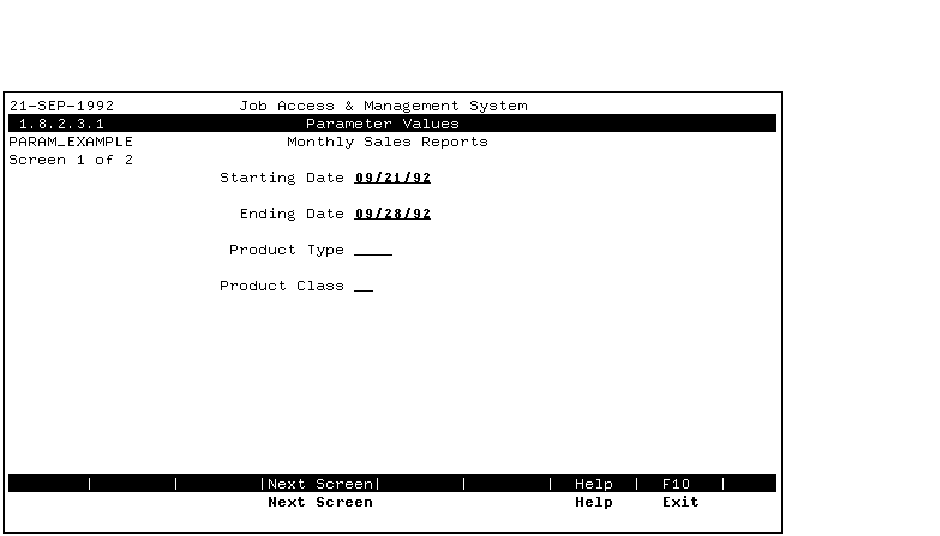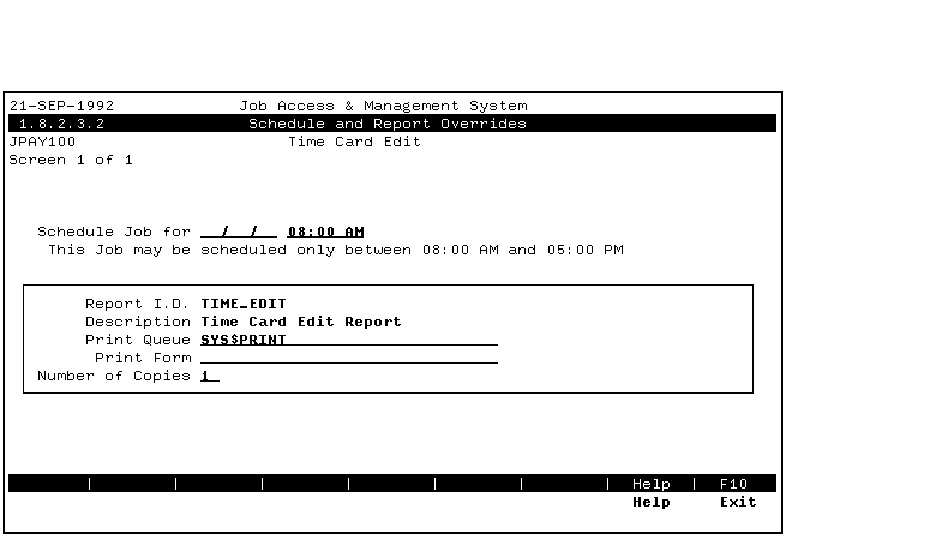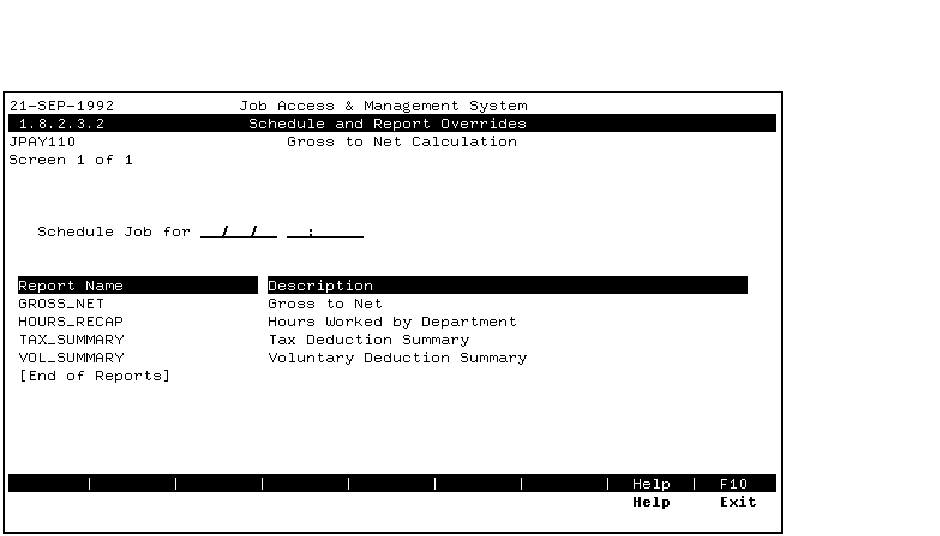
| Contents | Index | JAMS Home | Support |
 | ||||
|
| Previous | Contents | Index |
This chapter explains how JAMS can make it easier to submit batch jobs. Traditional job scheduling systems help manage regularly scheduled batch jobs. One of the strengths of JAMS is that it also helps you manage ad hoc jobs, job which are run only when needed. JAMS provides a simple, menu driven means to select a job and then uses "fill-in-the-blanks" video forms to prompt the user for the job's parameters and printing options.
While the end-user is responsible for requesting the job and providing
values for the parameters, JAMS still schedules the job based
upon the Job and System definitions which can be maintained by the MIS
Department.
9.1 Submitting a JAMS Job
The JAMS_MASTER program is used to submit batch jobs. JAMS_MASTER provides menu based access to job submission as well as a SUBMIT command which is very similar to the standard OpenVMS SUBMIT command.
Using JAMS does not preclude or diminish the value of
using the OpenVMS SUBMIT command. In fact, JAMS can track and
maintain history for jobs submitted via the standard SUBMIT command.
9.1.1 Replacing the OpenVMS SUBMIT Command
You can define a symbol which will simulate the standard OpenVMS SUBMIT command. JAMS accepts the SUBMIT command and many of the same qualifiers as the standard OpenVMS SUBMIT command. The following example shows how you can define a symbol to replace the OpenVMS SUBMIT command.
$ SU*BMIT :== $JAMS_EXE:JAMS_MASTER.EXE SUBMIT[Return] $ SUBMIT MYJOB |
This example defines the DCL symbol SUBMIT (which can be abbreviated to the first two or more characters), then uses this symbol to submit the Job MYJOB. The standard OpenVMS SUBMIT command would look for a file named MYJOB.COM in the current default directory and submit the command file to the SYS$BATCH queue.
JAMS would look for a Setup or Job named MYJOB in its database. If found, it would determine the name and location of the command file, prompt for any parameters, and submit the Job to the schedule. The Job may run in a queue or as a detached process, depending upon the Execution Method defined for the Job. The Job may be defined to run on OpenVMS, Windows NT, or a UNIX/Linux system.
Even though the Job is being initiated on OpenVMS, the Job itself may very well run on Windows NT or UNIX/Linux. The Execution Method along with the Agent Node determines how the Job is submitted, the Operating System it will run on, and the node where the Job runs. |
Command line access to JAMS batch jobs is generally used by
more technically oriented people. JAMS batch jobs can be very
useful for software development activities, such as program compiles,
because JAMS can save the value of a job's parameters in DCL
symbols so that the next time the job is submitted, the parameter
defaults are recalled.
9.2 Selecting a Job to Submit
If your site is a typical OpenVMS environment, you eventually accumulate hundreds or even thousands of batch jobs. JAMS can help you manage all these jobs and provide a menu based environment which will help you find the exact job which you want to submit.
If you know the name of the Job which you want to submit, you can use the JAMS SUBMIT command to submit the Job. In many cases, the exact name of a job is not remembered. This is when JAMS menu based access to batch jobs becomes indispensable.
The Job Submission menu option on the JAMS_MASTER main menu is the entry point to JAMS menu based job selection. A typical, user defined menu is shown in Figure 9-1.
Figure 9-1 Job Submission Menu

This menu has three columns, they are:
The list of line items may be longer than can be shown on the screen. You can use the arrow keys or the [Next Screen] and [Prev Screen] keys to scroll through the list of options.
Position the cursor on the desired line item and press
[Return]. If you selected another menu, the current line
items will be replaced by the line items from the selected menu. If you
selected a Job or Setup, a sequence of screens will be presented which
allow you to provide values for the Job's parameters and Report
overrides.
9.2.1 Parameters
When you use JAMS to submit a job which has parameters, a parameter form will be dynamically created and displayed. Each field on the form consists of the parameter's prompt text and a variable field where you can enter the value of the parameter. If a Job has many parameters, there may be more than one parameter form.
Figure 9-2 shows an example of a parameter entry form.
Figure 9-2 Sample Parameter Form

All of the fields on a parameter screen are user defined. Each field has one of four possible formats:
You can enter values for the parameters or accept the defaults. When JAMS determines the default value for a parameter, it takes the following steps:
After you have responded to any parameter forms, the Job/Report override form will be displayed. This form will vary depending on how many Reports are defined for the Job. If the the Job does not have any Reports defined, the form will contain only the Job overrides. If the Job has only one Report, the Job and Report override fields will be displayed on the same form.
Figure 9-3 shows an example of the Job/Report override form for a Job which has only one Report.
Figure 9-3 Sample Job/Report Override Form, one Report

The fields on this form are:
This is the date and time when the Job will be released to run. The Job is submitted immediately but, if a date and time is specified here, the job will remain in a pending state until the indicated date and time. This field is equivalent to the OpenVMS /AFTER= qualifier of the SUBMIT command.
This is the OpenVMS print queue where the indicated Report will be printed. The default is defined in the Report Definition. You can override this queue but any value you enter must be a valid OpenVMS print queue.
This is the OpenVMS print form which should be used when the indicated Report is printed. The default is defined in the Report Definition. If left blank, the default form of the specified Print queue will be used.
This is the number of copies of the indicated Report which should be printed. The default is defined in the Report Definition. To suppress printing of the Report, enter zero.
If the Job has more than one Report, the Reports are contained in a list along with the Job override fields. After filling in the Scheduled date and time, you can position the cursor to a specific Report and press the [Select] key to modify the Report's information. When you press the [Select] key, a pop-up form will appear which contains the same fields as a single Report screen.
Figure 9-4 shows an example of the Job/Report override form for a Job which has more than one Report.
Figure 9-4 Sample Job/Report Override Form, many Reports

| Previous | Next | Contents | Index |
| Copyright © 2000, MVP Systems, Inc. All rights reserved. |